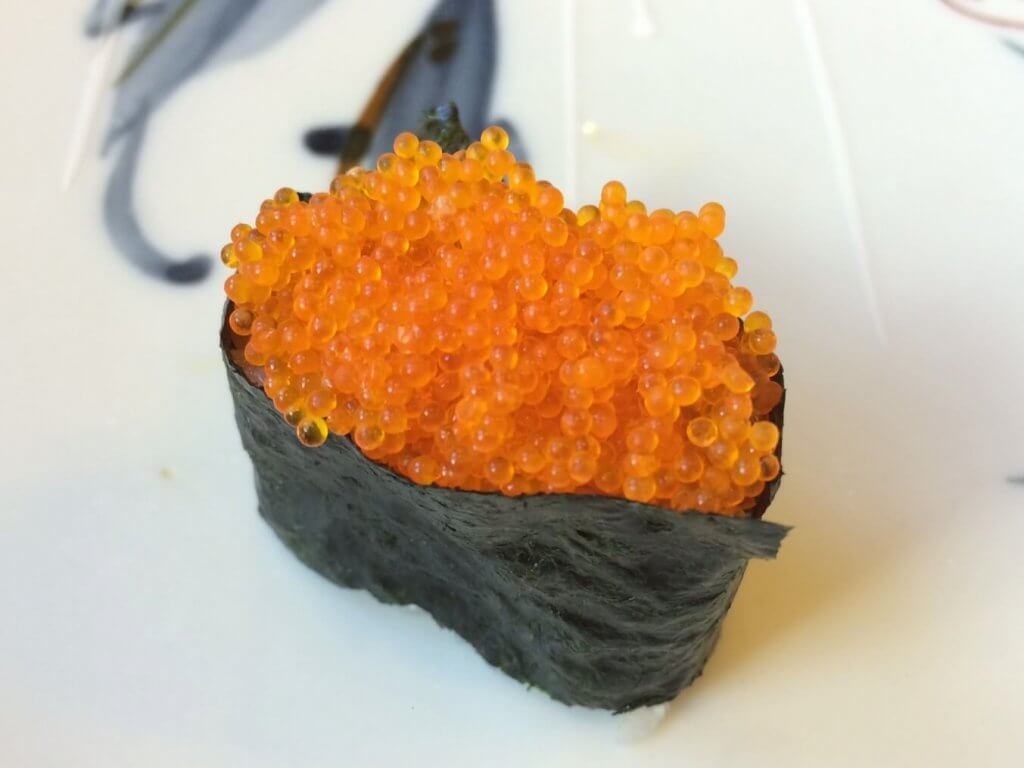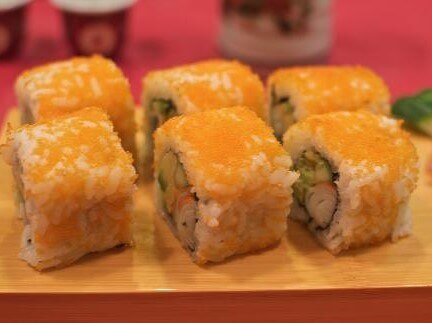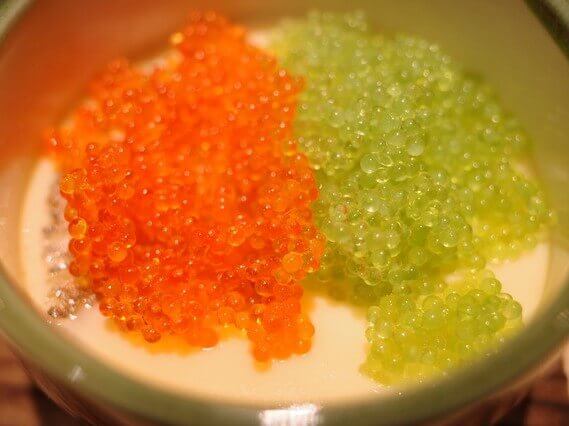
Tobiko and Masago often appear on sushi rolls around the world, but do you know the real difference between them? Whether you’re a sushi lover or just curious about what’s on your plate, this article explains everything from texture and flavor to nutritional value and even food fraud behind these colorful fish roes.
The tiny red balls around the outside of the rice on California rolls are Tobiko (飛び子). Specifically, they have salted roe of flying fish and are known for the plump, crunchy texture. This crunchy texture comes from the skin, which is relatively tough, even compared to other fish eggs. As the roe is made up of small eggs of only 1 to 2 mm, each one bursts as you bite, without leaving the outer skin in your mouth, so you can enjoy a nice texture that you won’t find with any other fish roe. Unlike the orange-colored tobiko sold in stores, natural tobiko has a pale golden color with a sense of transparency. Therefore, some processors have dubbed it “golden caviar”.
The main production areas are Indonesia and Peru, and in small quantities, Taiwan as well. The eggs from Indonesia are smaller than those from Peru. If you don’t like the skin remaining in your mouth then the Indonesian tobiko is recommended. Meanwhile, Peruvian roe has larger eggs and thus the skin is tougher, giving it an excellent firmness.
Freshly harvested flying fish roe gives you not only the satisfying popping texture like bubble wrap, but also a sense of the subtle aroma unique to fish roe. This combined with the saltiness of the sea gives you the same sort of umami found in tarako and ikura. Also, Tobiko sold at stores has even more added flavor. This is used for making hand-rolled sushi at home.
In fact, it is a registered trademark of a seafood processing company called Kanetoku (かね徳), located in Hyogo prefecture, Japan. It isn’t hard to see that it’s an abbreviated version of the Japanese “Tobiuo no ko”.
Tobiko is rich in nutrients such as the minerals and vitamins potassium, phosphorus, vitamin E, vitamin C and niacin. Also, since it has a natural pigment composition called astaxanthin, which gives tobiko its bright color, it has antioxidative effects and is effective in strengthening the immune system. While Ikura has 272 kcal per 100 g, Tobiko only has 74 kcal per 100 g, adding a health factor to its charm.
What is flying fish?
Flying fish are found in the subtropical to temperate waters of the Pacific Ocean, Indian Ocean, and the Atlantic Ocean. They travel along the surface of the sea and eat zooplankton. Over 50 types of flying fish have been identified around the world. More than 30 of these have been identified in Japan, of which 4 types are used as food. Since the meat is white, low in fat, and has little odor, it is prepared in various ways such as sashimi, minced, grilled with salt, and fried. In Kyushu, flying fish is called “ago,” and it is dehydrated to be used as soup stock, called “dashi” in Japanese. Ago dashi has a refined and refreshing sweetness and a deep flavor, and it is considered to be on the higher-end of dashi stock.
The dorsal side of the flying fish is a vibrant dark blue, and the ventral side is silver The pectoral fin is considerably longer at about 30-40 cm long. It uses it pectoral fins to fly over the water’s surface to escape from its natural enemies, such as tuna Depending on the breed, it can fly an average of 200 m in one go. The larger the species, the longer distance it can fly and the longest can be up to even 600 m. Furthermore, the flying fish has no stomach and its other digestive organs are short and straight, which makes its body lighter and ideal for extended flight.
Flying fish contains a lot of a nutrient called Niacin which can help prevent hangovers. Additionally, it is rich in vitamin E, which works to prevent the oxidation of unsaturated fatty acids in the body, and as such is a good fish for preventing lifestyle-related diseases such as arteriosclerosis and myocardial infarction.
 On the other hand, an orange-colored tobiko is often seen at conveyor belt sushi restaurants, etc., but this is the roe of a fish called capelin (カペリン), which is similar to shishamo smelt. A salted version of this is used for sushi rolls in the US and other places, where it is called masago. Compared to tobiko, the grains are smaller and the texture is a bit chewier. It is mainly rich in EPA (Omega-3 fatty acids) and collagen.
On the other hand, an orange-colored tobiko is often seen at conveyor belt sushi restaurants, etc., but this is the roe of a fish called capelin (カペリン), which is similar to shishamo smelt. A salted version of this is used for sushi rolls in the US and other places, where it is called masago. Compared to tobiko, the grains are smaller and the texture is a bit chewier. It is mainly rich in EPA (Omega-3 fatty acids) and collagen.
“Masago (真砂子)” actually means “fine sand” and therefore is used for foods that depict that image. In other words, it refers to broken-up fish roe and doesn’t indicate a specific type of fish. Dishes made using capelin roe can be called masago, but please keep in mind that dishes with broken-up tarako or kazunoko are also called masago.
What is capelin?
The shape of capelin is very similar to shishamo smelt, but the scales are very fine, barely visible to the eye. The body is a bluish silver color with an average length of 12-16 cm, but can grow up to 20 cm.
It is found in a wide area from the Arctic Ocean to the frigid sea regions and also migrates to the Sea of Okhotsk on the coast of Hokkaido. The time they spawn depends on the region. The season for Canadian capelin is June to mid-July, and the season for Icelandic and Norwegian capelin is mid-February to mid-March.
They are also known as Komochi Shishamo (Shishamo with child) and are known to have a wonderful balance of fat and roe. Compared to shishamo smelt, they are leaner and have a lighter texture. Shishamo smelt is not caught in great numbers, so capelin started to be imported as a substitute for it for Japanese homes and izakaya (Japanese bar/restaurants).
Capelin rush to the coastal area in large groups to lays eggs on the sandy bottom of the beach during spawning season. The amount of eggs it lays at one time is about 5,000 to 6,000. It has spherical, adhesive demersal eggs with a diameter of around 1 mm. The eggs hatch around spring tide about 2 weeks after spawning The total length of larvae immediately after hatching is 4-5 mm, and it is thought that they leave the coastal area by utilizing waves at high tide and reach a total length of around 10 cm in the first year of life.
Capelin is a healthy fish that can be eaten in its entirety, and boasts 7 nutrients (DHA, EPA, calcium, zinc, potassium, vitamin B2, collagen). Moreover, since the sugar content is only 0.5 g per fish, about 1/3 of the amount normally contained in fish, it is perfect for those who are dieting.
If you come across wholesale Tobiko and Masago, it was likely purchased at the Toyosu Market. The reason for the ambiguous expression here is that you will rarely find nigiri sushi with tobiko or masago at sushi restaurants with counters. There may be some sushi restaurants that have tobiko or masago on their standard menu, but there are fewer than ten of those restaurants in Tokyo. In other words, in Japan, tobiko and masago are mainly used for kaiten-zushi (conveyor belt sushi) and izakaya restaurants.
 Finally, we’ll let you in on a not-so-pleasant secret. Flying fish and capelin roe is actually a light yellow or beige color. However, you’ll find it in bright red, orange, yellow and lately even green or black. Of course, these are colored by either natural pigments or synthetic coloring. Furthermore, tobiko is sometimes mixed with the cheaper capelin or herring roe. Unfortunately, food fraud is common in seafood products that are consumed in high quantities.
Finally, we’ll let you in on a not-so-pleasant secret. Flying fish and capelin roe is actually a light yellow or beige color. However, you’ll find it in bright red, orange, yellow and lately even green or black. Of course, these are colored by either natural pigments or synthetic coloring. Furthermore, tobiko is sometimes mixed with the cheaper capelin or herring roe. Unfortunately, food fraud is common in seafood products that are consumed in high quantities.
In summary, while Tobiko and Masago may look similar on your sushi roll, they come from different fish, have unique textures, and vary in price, flavor, and nutrition. The next time you enjoy sushi, you’ll know exactly what you’re tasting.
If you’d like to learn more about sushi ingredients and how they’re used in Japan, check out our other articles on Ikura, Tarako, or Ago-dashi. And don’t forget to always check the labels—looks can be deceiving!
Related contents:
What are the difference between Tarako and Mentaiko?
[sc_apply url=”https://sushiuniversity.jp/apply/”]
We hope this information will be helpful.

Revision date: July 30, 2025
Share this article